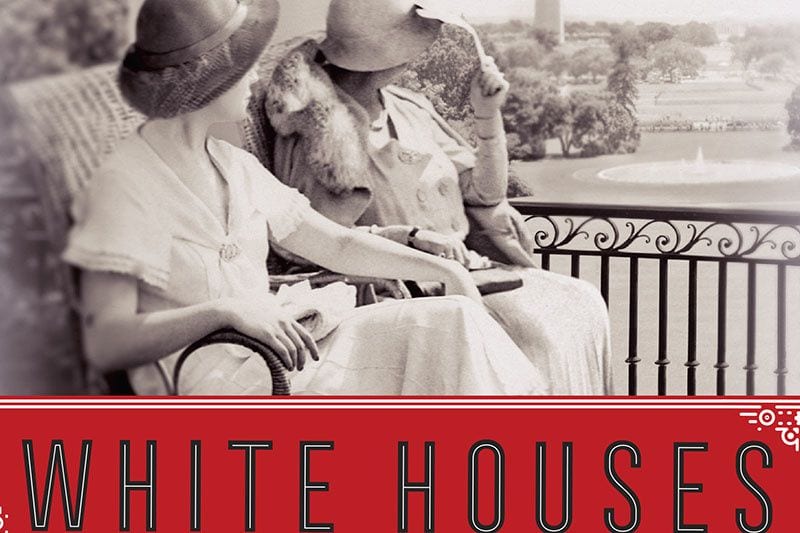
Queering history is necessary if readers want to fully understand how the past influences the present. Regardless of the classification as fiction or non-fiction, texts that queer reader’s understanding of gender and sexual fluidity are essential. However, queering history doesn’t necessarily require the outing of sexual activity. This methodology allows authors and readers to examine a wider spectrum of social and cultural relationships. White Houses by Amy Bloom provides that perspective. In this work of historical fiction, Bloom creatively conceptualizes the relationship between first lady Eleanor Roosevelt and journalist Lorena “Hick” Hickok. At times mawkish and problematic, White Houses is a romance that presents an interesting queer historical fiction.
White Houses, named after 1600 Pennsylvania Ave and a home on Long Island, is told from Hickok’s perspective. This is a refreshing change from having Roosevelt’s voice dominant another narrative. Bloom details Hickok’s struggle to obtain an education, break the cycle of poverty, and construct a unique identity. The novel’s crux imagines the details of Hickok’s relationship with Roosevelt. While an AP reporter, Hickok met Eleanor during Franklin Roosevelt’s first presidential campaign. Their affective connection was instantaneous and intense. This caused Hickok to resigned from the AP because she couldn’t maintain objectivity. She then moved into the White House and became known as the “First Friend”. That moniker is interpretable as the code for a closeted partner. As such, Bloom moves beyond the dominant narrative to construct their partnership as a deeply emotive lesbian relationship.
Hickok is funny. Her humor is sharp-witted and self-deprecating. White Houses is consistently laced with zingers where Hickok ridicules herself and debases those around her. During a flashback of her childhood, Hickok remembers a neighborhood mother who tried to give Hick, a tomboy, a makeover. Upon assessment of the new look, Hickok concludes that she “was pretty much tying a ribbon on a side of beef” (41). No one is safe from Hickok’s discerning sense of humor. Even Roosevelt, the woman she endlessly respects, is the target of her scorn. Throughout White Houses she’s critical of Roosevelt who is “open, tolerant, and determined to give every idiot the benefit of the doubt” (157).
Yet at times Hickok’s brutal honesty is too churlish. Unexpectedly, a new paragraph starts with Hickok saying, “I banged the living daylights out of an old girlfriend in San Fran” (103). Or when Hickok identifies “a pair of red fuck-me pumps” (168) after she assesses her other girlfriend’s appearance. These euphemisms seem anachronistic and unintentionally makes the novel more akin to amateurish erotic fan fiction. It’s unclear whether Bloom took creative liberties with Hickok’s voice, or if the historical record supports the crassness.
By contrast, Bloom is careful in imagining Hickok’s and Roosevelt’s sexual romps. Their sex isn’t porny and is frequently alluded to by lines such as “they hadn’t been out of bed for hours” (209). Bloom does not sensationalize their relationship or overly eroticize their connection. Ratherm Bloom focuses on how their intimacy was built on an emotional and psychological connection rather than pure physicality. For both Hickok and Roosevelt their relationship was of “remarkable kinship, [their] communing spirits” (137). Bloom’s version imagines an affair of the mind and soul.
At one point, White Houses becomes Tod Browning’s 1932 movie, Freaks. A young Hickock joins a low-budget traveling circus as a secretary. Predictability, she feels accepted, harkening the film’s classic line “we accept her. One of us, one of us…” (1932). Hickok and the community of circus performers find affinity as “God’s conspicuous errors” (59). Writing queer characters as self-proclaimed ‘errors’ is problematic, especially if it doesn’t reflect historical accuracy. Bloom thoroughly researched the extant primary sources prior to writing White Houses. Significantly, this scene contrasts with the rest of the novel. Essentially the circus is meant to evoke Hickok’s search for identity. But to develop self-awareness amongst a group of ‘conspicuous errors’ is trite. All this does is maintain a sense of internalized homophobia without challenging the misconception.
Hickok’s understanding of class is White Houses’ most engaging element. She makes very astute observations of Roosevelt’s privilege and “her Hyde Park-iness” (149) in contrast to Hickok’s impoverished upbringing in the “South Dakota gloom” (149). However, Hickok does not wallow in her lack. When touring the United States, Hickok checks her own privilege when she sees the dire poverty caused by the Great Depression. She is taken aback by how race adds another element of oppression. She specifically notices “negro men and women, working from can to can’t, surrounded by a sea of hungry, wide-eyed children…” (113). Bloom also makes it clear to readers that both Hickok and Roosevelt were motivated by their deep compassion for other humans. This element is affirmed in the discussions on class, race, and privilege. Bloom expertly demonstrates the intersection of oppression as more complicated than a single cultural condition.
Historians might never know the real truth about Eleanor Roosevelt’s and Lorena Hickok’s relationship. Bloom takes creative liberties to imagine the details the public may never know. Hence, queering history enables the questioning of prominantent historical individuals’ gender and sexual performances. Regardless of the authenticity, White Houses is Lorena Hickok’s story that centralizes a deeply intimate relationship. In doing so, Bloom situates White Houses as a provocative queer reading of two prominent historical women.

